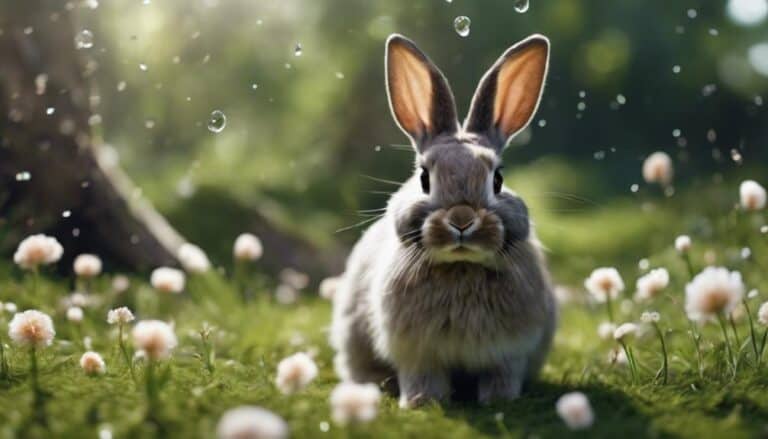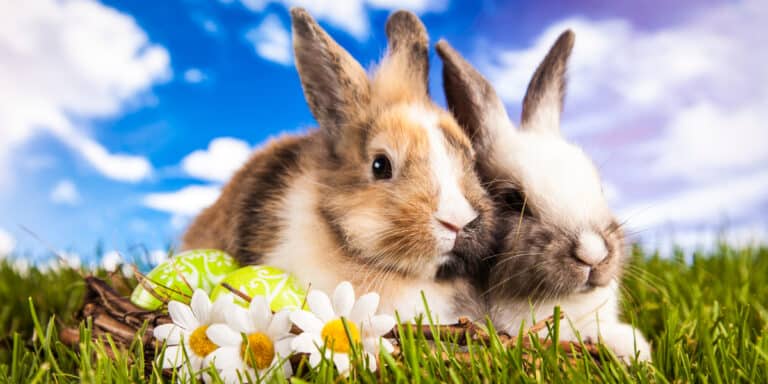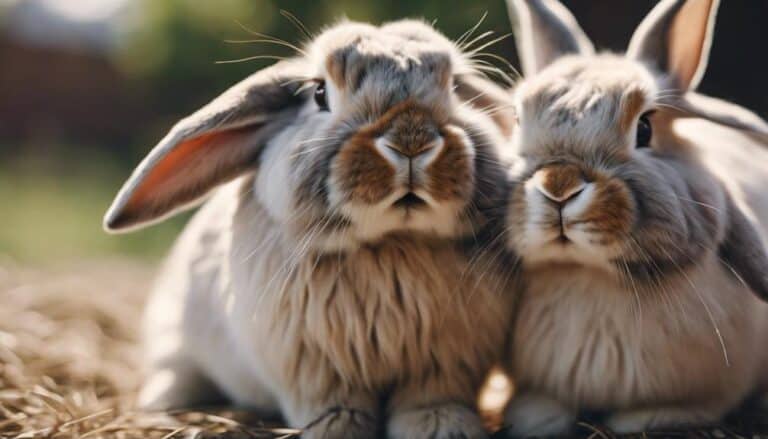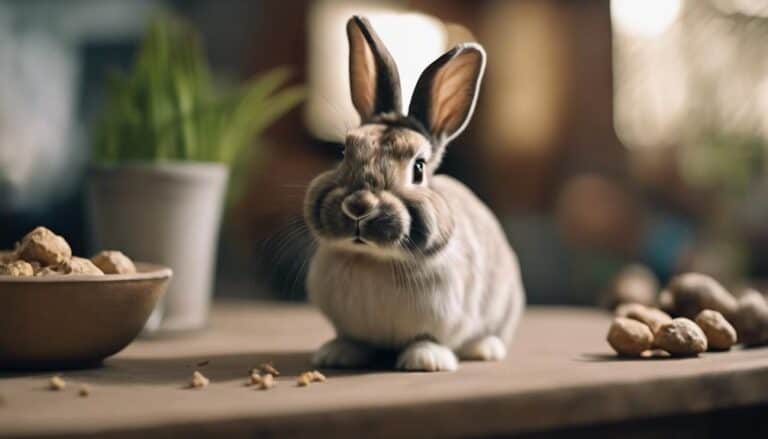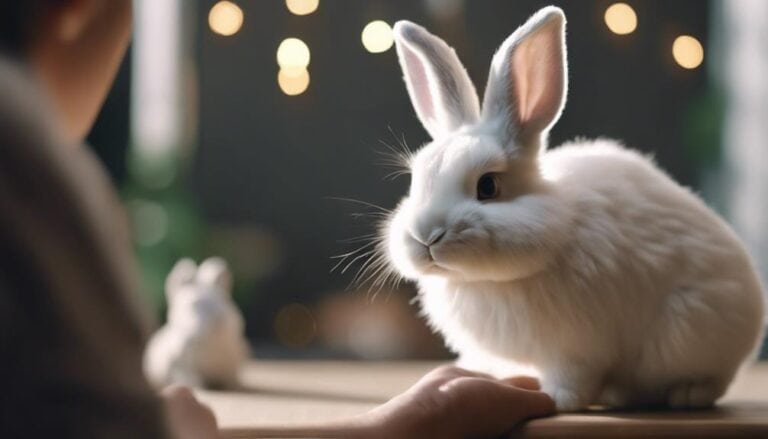Imagine observing your two bunnies as they engage in a subtle yet intricate dance of bonding behaviors.
As you witness their interactions, you start to notice the nuanced ways they communicate with each other. Understanding these signals is vital for a successful bonding journey between your rabbits.
But what specific behaviors should you pay attention to, and how can you decode their silent language?
This guide will shed light on these essential aspects of rabbit bonding, providing you with valuable insights to navigate this fascinating process with confidence.
Contents
- 1 Key Takeaways
- 2 Importance of Bonding for Rabbits
- 3 Duration of Rabbit Bonding Process
- 4 Managing Separate Living Arrangements
- 5 Impact on Rabbit-Human Relationship
- 6 Preparing for Successful Bonding
- 7 Behavioral Expectations in Bonding
- 8 Strategies for Bonding Techniques
- 9 Tips for Facilitating Rabbit Bonding
- 10 Frequently Asked Questions
- 11 What Are the Best Ways to Bond Bunnies Based on Their Behavior and Communication?
- 12 Conclusion
Key Takeaways
- Neutering reduces aggression and aids in forming harmonious relationships.
- Monitor behaviors closely to prevent and intervene in potential aggression promptly.
- Utilize neutral territories and gradual introductions to facilitate bonding.
- Clear communication, patience, and supervision are essential for successful rabbit bonding.
Importance of Bonding for Rabbits
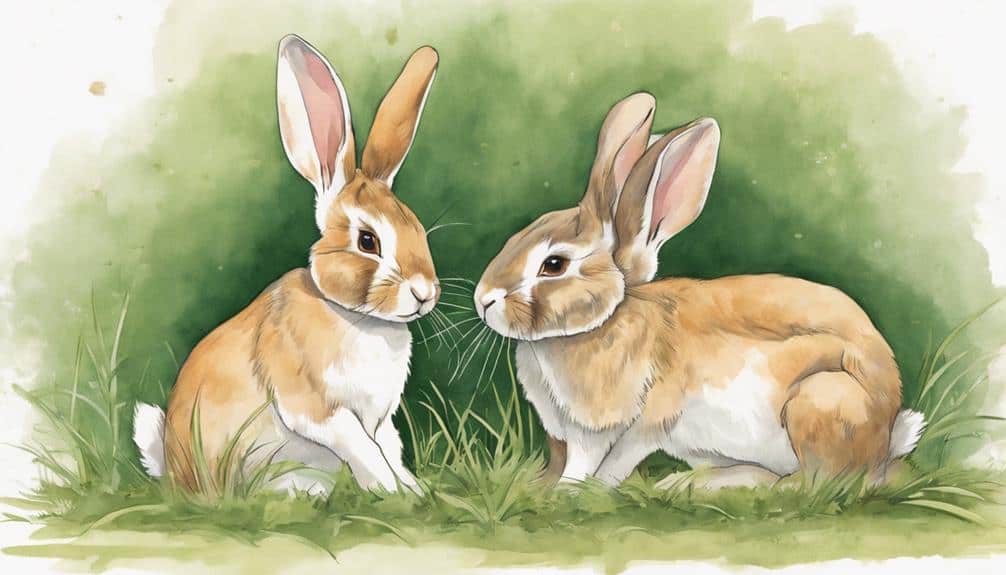
Bonding is essential for rabbits due to their social nature, fostering strong companionships and preventing aggression through hierarchy establishment. Rabbits are highly social animals that thrive on companionship, making bonding a critical aspect of their well-being.
When rabbits bond in a neutral territory, they've the opportunity to build trust and familiarity with each other, laying the foundation for a successful relationship. Establishing hierarchy during the bonding process is important as it helps prevent fighting and aggression between the rabbits.
Supervision plays a key role in ensuring the safety of the rabbits and the success of their bond. Neutering all rabbits involved before bonding is recommended as it reduces aggression, making it easier for them to form a harmonious relationship.
Duration of Rabbit Bonding Process
The timeframe for establishing a bond between rabbits can vary greatly, influenced by factors such as their individual personalities, past experiences, and environmental conditions. Some rabbits may quickly form a strong bond, while others may require more time and patience. Understanding that each rabbit is unique, and their bonding process will unfold at its own pace is crucial.
Factors such as past trauma or negative experiences can impact how quickly rabbits trust and bond with one another. Creating a supportive environment, free of stressors, can greatly aid in expediting the bonding process. Providing ample space for the rabbits to interact, along with hiding spots for retreat if needed, can foster positive interactions.
During the bonding process, observe the rabbits' behavior closely. Signs of aggression or fear may indicate a need to slow down and reassess the introduction. Patience is key in allowing the rabbits to establish a harmonious relationship, ensuring a successful and lasting bond.
Managing Separate Living Arrangements
When managing separate living arrangements for your rabbits, consider the housing space carefully to make sure they're close enough to promote familiarity without causing stress.
Introducing them for bonding should be done gradually, allowing them to get used to each other's presence.
Monitor their interactions closely to prevent any potential conflicts and guarantee a smooth bonding process.
Housing Space Considerations
To optimize the bonding process between rabbits, strategically managing separate living arrangements is important for their initial interactions and eventual harmonious cohabitation.
Housing rabbits in separate enclosures but close enough to interact through sight and smell is important. Providing individual living spaces helps reduce territorial behavior, promoting a smoother bonding process. Separate enclosures also prevent fights and allow rabbits to adjust to each other's presence gradually.
Through the barriers of their housing spaces, rabbits can communicate and bond. This initial separation guarantees a gradual introduction, reducing stress and potential conflicts during the bonding process.
Transitioning for Bonding
Optimizing the bonding process between rabbits involves strategically managing their separate living arrangements to guarantee a smooth shift towards harmonious cohabitation.
When shifting for bonding, consider the following:
- Neutering: Make sure both rabbits are spayed or neutered to reduce aggressive behaviors during the bonding process.
- Neutral Space: Introduce rabbits in a neutral space to prevent territorial behavior and signs of aggression.
- Side-by-Side Housing: Utilize side-by-side housing to allow rabbits to interact visually without direct contact, helping them get accustomed to each other before formal bonding.
Monitoring Interactions Closely
Monitoring interactions closely between rabbits in separate living arrangements is crucial for evaluating bonding progress and behavior. Separate living spaces can reduce stress and aggression during the bonding process, preventing territorial disputes.
Supervision during bonding allows for the identification of positive signs of bonding readiness. Managing separate living arrangements guarantees safety and a gradual introduction for the rabbits.
By monitoring interactions closely, you can guarantee that the bonding process is conducted in the right manner, fostering a healthy relationship between your rabbits. Remember to observe their behavior carefully, intervene when necessary, and provide a safe environment for them to bond effectively.
This hands-on approach will help create a harmonious living situation for your rabbits.
Impact on Rabbit-Human Relationship
When engaging in trust-building activities with your rabbit, you can expect to see an improvement in your relationship through increased mutual understanding.
By recognizing and responding to non-verbal cues, such as body language and vocalizations, you can further solidify your bond with your pet.
The benefits of cross-species bonding are evident in the enriched connection that comes from investing time in learning your rabbit's behaviors and preferences.
Trust Building Activities
To enhance the bond and trust between you and your rabbits, engaging in grooming sessions can be a highly effective trust-building activity. By spending time petting and massaging your rabbits, you can help them associate vital experiences with your presence.
Additionally, providing treats like mashed banana or applesauce on their foreheads can encourage grooming behavior and further strengthen the bond and trust. Creating a vital environment during bonding sessions is essential for promoting effective communication and trust with your rabbits.
Remember to end each session on a high note, either with petting or treats, to reinforce the vital associations and continue building trust. Trust-building activities like grooming and providing treats are essential for deepening your relationship with your rabbits.
Cross-Species Bonding Benefits
Building trust and strengthening the bond between rabbits and humans through cross-species bonding activities offers numerous benefits that positively impact the rabbit-human relationship.
Cross-species bonding benefits include increased socialization for rabbits, providing them with improved mental stimulation. Human interaction can reduce stress and anxiety in rabbits, leading to better overall health.
Additionally, spending time with humans helps rabbits become more comfortable with handling and grooming, enhancing their well-being. These positive interactions foster trust and confidence in rabbits, ultimately improving their quality of life.
Understanding Non-Verbal Cues
Understanding a rabbit's non-verbal cues is imperative for fostering a strong and harmonious relationship between rabbits and their human caregivers. When interacting with your rabbit, pay close attention to their body language and gestures. Here are some key points to ponder:
- Tail Wagging: This behavior can indicate excitement, curiosity, or happiness in response to human interaction.
- Eye Contact: Avoid direct eye contact with rabbits, as they may perceive it as a challenge or threat during communication.
- Interpreting Subtle Signals: Learning to interpret subtle signals like tooth-clicking, thumping, or circling can help enhance communication and mutual understanding with your rabbit.
Preparing for Successful Bonding

Before you start the bonding process between your rabbits, it's important to make sure that all rabbits involved have been spayed or neutered. This step is essential to prevent unwanted litters and reduce hormonal aggression during bonding.
Selecting a neutral territory for the initial introductions is key to creating a balanced environment where rabbits can build trust without feeling territorial. Supervision plays a critical role in ensuring the safety of the rabbits and a smooth bonding process. By closely monitoring their interactions, you can intervene if any signs of aggression arise.
To facilitate familiarity, house the rabbits side by side and swap enclosures regularly to let them get accustomed to each other's scents. Understanding the social needs of your rabbits is essential; make sure you have the necessary resources and time to care for multiple rabbits before proceeding with the bonding process.
Effective communication, patience, and a conducive environment are fundamental to successfully bonding your rabbits.
Behavioral Expectations in Bonding
To navigate the behavioral expectations in bonding your rabbits, it's essential to recognize and manage dominance behaviors such as humping that establish hierarchy within their relationship. Chasing is a common behavior during bonding, but it should be monitored closely to prevent potential aggression. Nipping and biting are forms of communication among rabbits during the bonding process, often used to establish boundaries and communicate discomfort.
Understanding the signs of escalating aggression is vital to intervene promptly and prevent fights that can hinder the bonding progress. Additionally, being aware of territorial behavior and the need for a slow bonding process can help prevent conflicts between rabbits. By allowing them to gradually adjust to each other's presence and territory, you create a more stable foundation for a successful bond. Effective communication between the rabbits, as well as from you as the caretaker, is key to promoting a harmonious relationship as they establish their hierarchy and bond.
Strategies for Bonding Techniques
Implementing various bonding techniques is essential for successfully introducing and integrating rabbits into a harmonious relationship. To bond two rabbits effectively, start in a small space like a laundry basket to reduce stress and promote initial communication. Utilize gentle bonding techniques if the rabbits are calm, and consider stress bonding for anxious rabbits. Combining these methods can accelerate the bonding process, especially when dealing with initial aggression.
Neutering all rabbits involved is vital to minimize aggression and enhance the likelihood of successful bonding. As the rabbits become more comfortable with each other, gradually increase their space and time together. This incremental approach can help reduce aggressive behaviors and foster a stronger bond. Remember that clear communication, patience, and consistent interaction are key elements in facilitating a positive relationship between bonded rabbits.
Tips for Facilitating Rabbit Bonding
Utilizing neutral territory is essential in reducing territorial aggression during the bonding process between rabbits. When facilitating the bonding of a bonded pair, consider the following tips:
- Incorporate Scent, Sight, and Snacks: Introduce rabbits to each other using these cues to help them familiarize themselves with one another in a non-threatening way.
- Monitor Relaxation Signs: Before progressing bonding interactions, observe your rabbits for signs of relaxation such as lying down or grooming. This indicates they're more receptive to bonding.
- Be Prepared to Intervene: Despite best efforts, conflicts may arise. Be ready to step in and separate the rabbits if fighting occurs to prevent any serious harm.
Frequently Asked Questions
What Is a Rabbit's Behavior When Bonding?
When bonding, a rabbit's behavior encompasses a range of actions. From grooming rituals to binky dances, nipping behavior to thumping responses, and flopping positions to snuggling techniques, they communicate through chinning territory and licking bonding.
What Are the Positive Signs When Bonding Rabbits?
When bonding rabbits, look for positive signs like grooming exchanges, binky hopping, nuzzling closeness, flopping together, shared food, play chasing, snuggling sleep, and litter sharing. These behaviors signify trust, friendship, and a strong bond.
What Is the Body Language of Bonding Rabbits?
When bonding, rabbits display a range of body language cues. Look for ears twitching, nose nuzzling, tail wagging, eye contact, head tilting, paw touching, body circling, and mutual grooming. These behaviors signify their connection and trust.
What Is the Timeline for Bonding Rabbits?
When bonding rabbits, the timeline varies. Progress hinges on interaction frequency, trust building, and maneuvering setbacks. As they explore together, establish a social hierarchy, engage in grooming sessions, and share space, their bond strengthens.
What Are the Best Ways to Bond Bunnies Based on Their Behavior and Communication?
Understanding bunny bonding behaviors is essential when trying to bond bunnies. Observe their body language and vocalizations for clues about their feelings. Slow introductions and neutral territory can help reduce stress during the bonding process. Positive reinforcement and patience are key to successful bunny bonding behaviors.
Conclusion
To summarize, bonding bunnies requires patience, understanding, and a keen eye for communication cues.
Just like a delicate dance, the process of rabbit bonding involves intricate steps and moves that can lead to a harmonious relationship between your furry friends.
By implementing the strategies and tips outlined in this guide, you'll be well on your way to creating a strong and lasting bond with your beloved bunnies.
So, hop to it and start building that bunny bond today!

